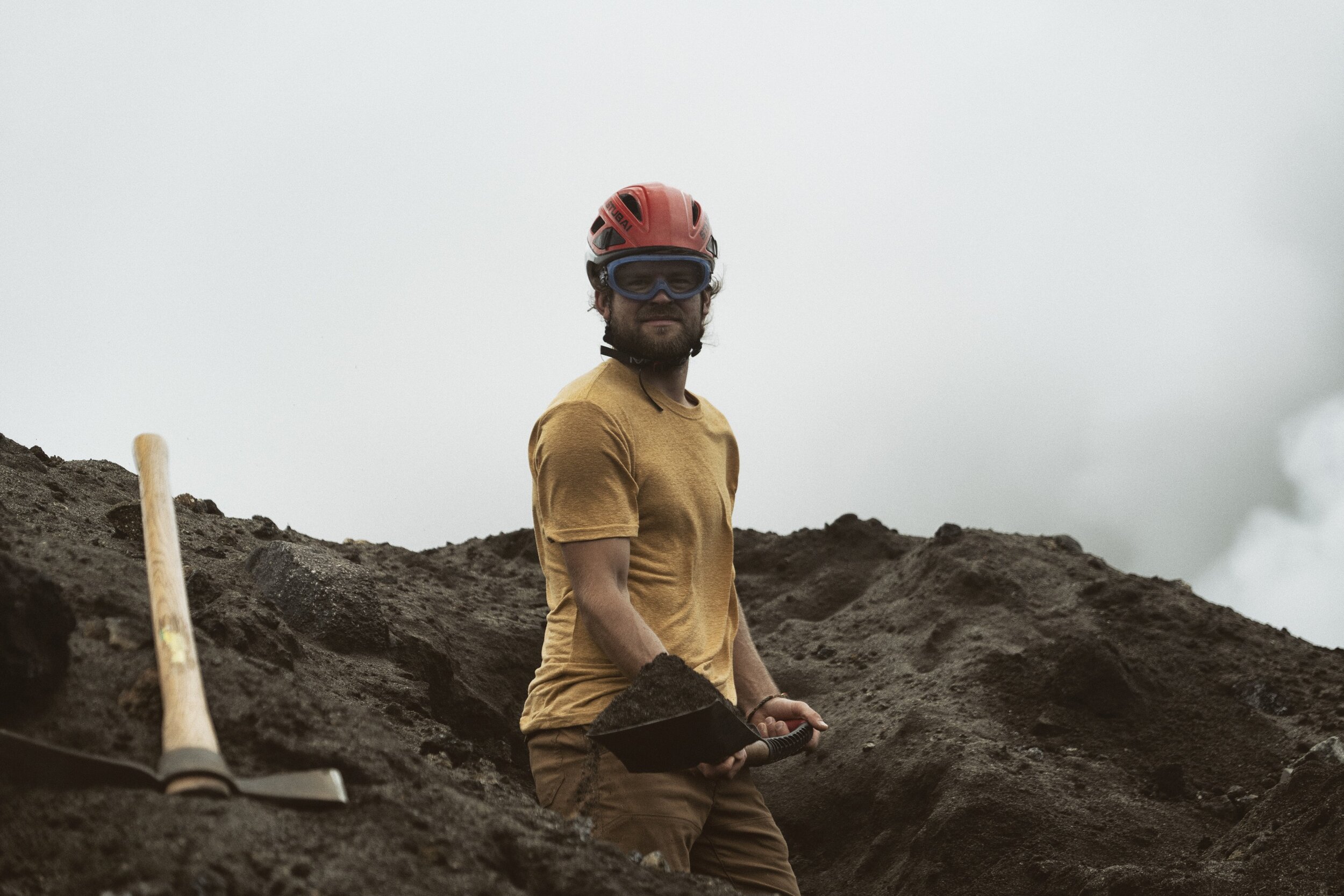How to Rig a Slackline over an active Volcano
How to Rig a Slackline over an active Volcano
Wondering how we set up a highline next to an active vulcanoe? It turned out to be an adventure of its’ own! Read here about the biggest challenges we faced.
01.04.2020 Yasur
I’m standing, chainsaw in hand, at the southern rim of one of the most active volcanoes in the world. Rafael and Marinus are by my side with pickaxe and spade. We are here to prepare the anchor points for the highline. No tree can grow in this hostile environment, but ever since Will Smith roped a few meters down into the crater five months ago, there has been enough wood lying around. Or first working first step is digging the so-called ‘Totmann’-anchors - German meaning ‘dead man’s anchors’ – into the ground. The ash, which is loose at the top and gets more compressed the further you go down, is riddled with lava bombs. Starting at half a meter’s depth it gets unpleasantly hot. We have to dig just over one meter deep on both sides. Into that hole, we lower the wooden support beams with iron chains attached to them, and fill it up with dirt. There is a breaking load indicated on the chains, but we’re not sure if we can rely on it in these conditions. To be safe we add Kevlar & Dyneema ropes. Kevlar for the heat and Dyneema for acid resistance. The ropes are tied to wooden constructions made of thick tree trunks. The higher of the two is a so-called hang frame, which provides more stability. Our working environment could not be more exciting, but also distracting: Every few minutes there is a huge rumbling next to us and one of the many craters spits out a fountain of lava and ash, the lumps of which fall down 50 meters next to us. A real End-Time-Scenario!
During the first visit to the site we measured out the distance between the anchor points and found it to be 260m; 20m more than the length of our setup. In order to compensate we have to lengthen the BalanceCommunity slacklines with ropes during taping. During this procedure, Rafa and Marinus develop a new application of the half-mast throw knot. As a safety feature, mainline and backup are connected to each other every 60m with soft shackles to reduce the height of the fall in case someone slips.
Before the slackline is unpacked, we all get together and assess the likelihood of rain. We need to jointly decide whether we risk a walk now - the problem is the sulphur at the volcano. When it comes into contact with water, as in the case of rain, an extremely aggressive sulphuric acid is created that can easily attack and decompose textile materials. Precise weather forecasting is impossible here in the tropics: a downpour often comes within minutes. According to the locals, however, it rains less at the top of the volcano because the rising heat pushes the humid air away, so to speak.
We decide to risk it and start laying out the slackline bands at the crater rim. Because of the strength of the storm winds, we have to weigh the line down with the scattered lava bombs so that it isn’t blown into the crater. Once fully around, we realize that the setup is still too short in the untightened state. We extend the last 20 meters with rope and release the slackline from its intermediate anchors on the ground. Due to the strong wind, too much force is applied to the Micro Traxion while pulling in, so that I have to spontaneously lower myself into the crater to retrieve the end of the line. When attaching the line the AWL 5 saves us valuable minutes, thanks to its useful anti-slip and back-up functions. But despite all time-saving measures, when we are finally done setting up, sunset is just around the corner.
In my next blog, I’ll tell you all about the world-record walk itself and what was going through my head during it. So much in advance: Fear, respect, admiration, fascination, and gratitude were all among my feelings.
As we dismantle the set-up we hurry because we fear rain might be coming. At the same time, we have to remain vigilant not to be pulled into the crater by the line. While doing this work we come just as close to the eruptions as I was on the highline.
Four days later when coming back for another take, we would notice that the chains had already begun corroding. Good thing we didn't also leave the anchor ropes and slacklines there... Before the next setup, we have to find new chains and dig the wood supports out and in again.
The slackline next to an erupting volcano was our most exciting rigging experience so far and under the most extreme circumstances!








